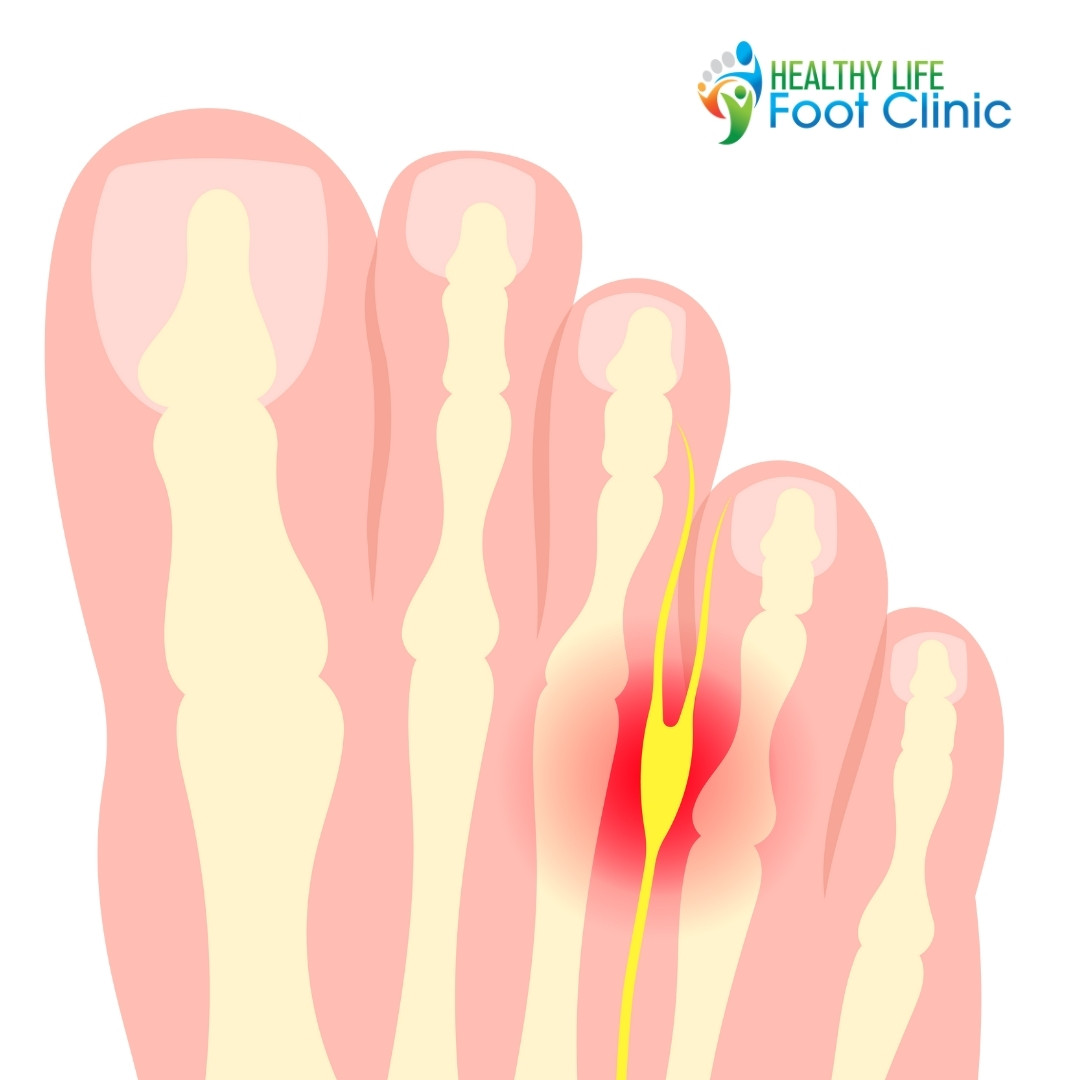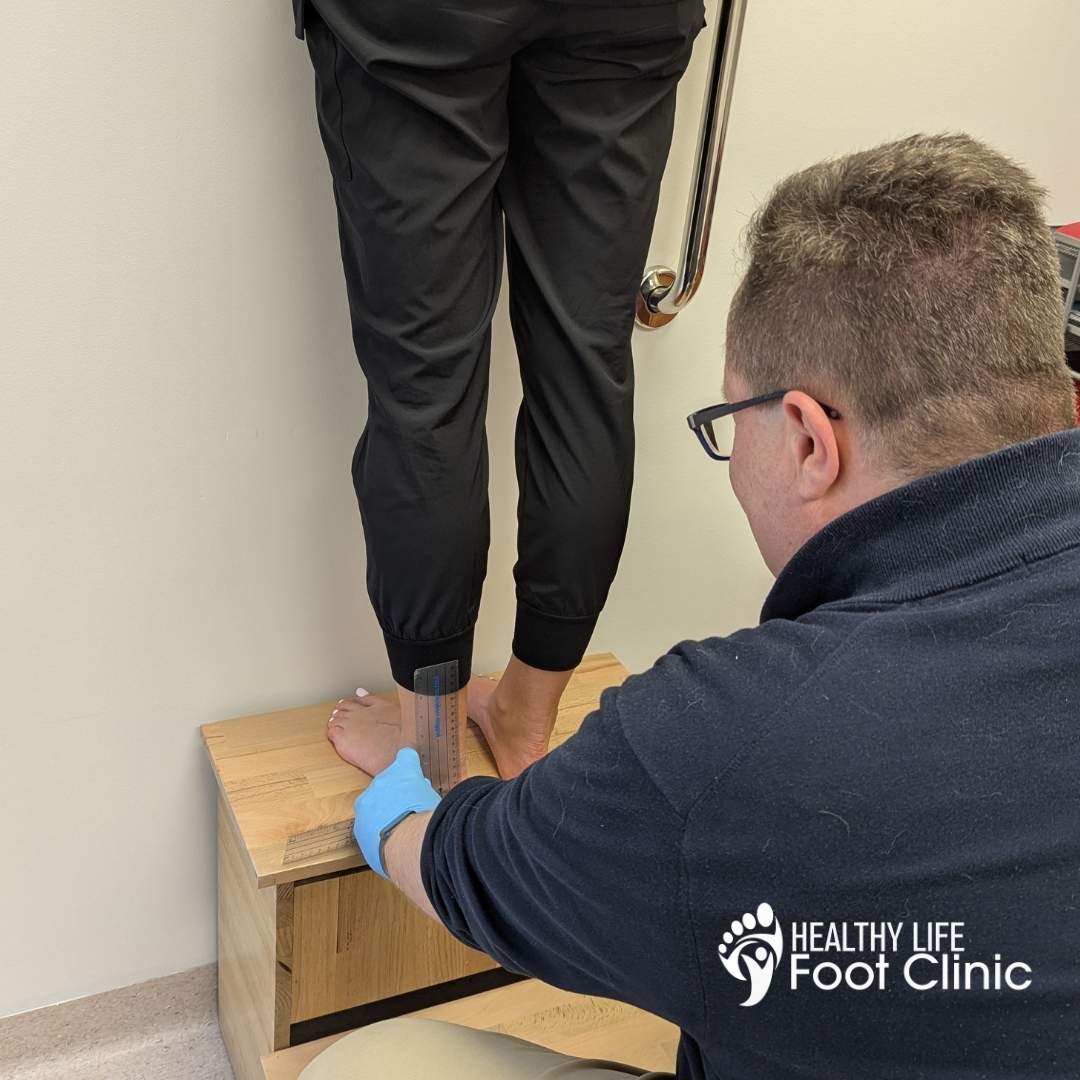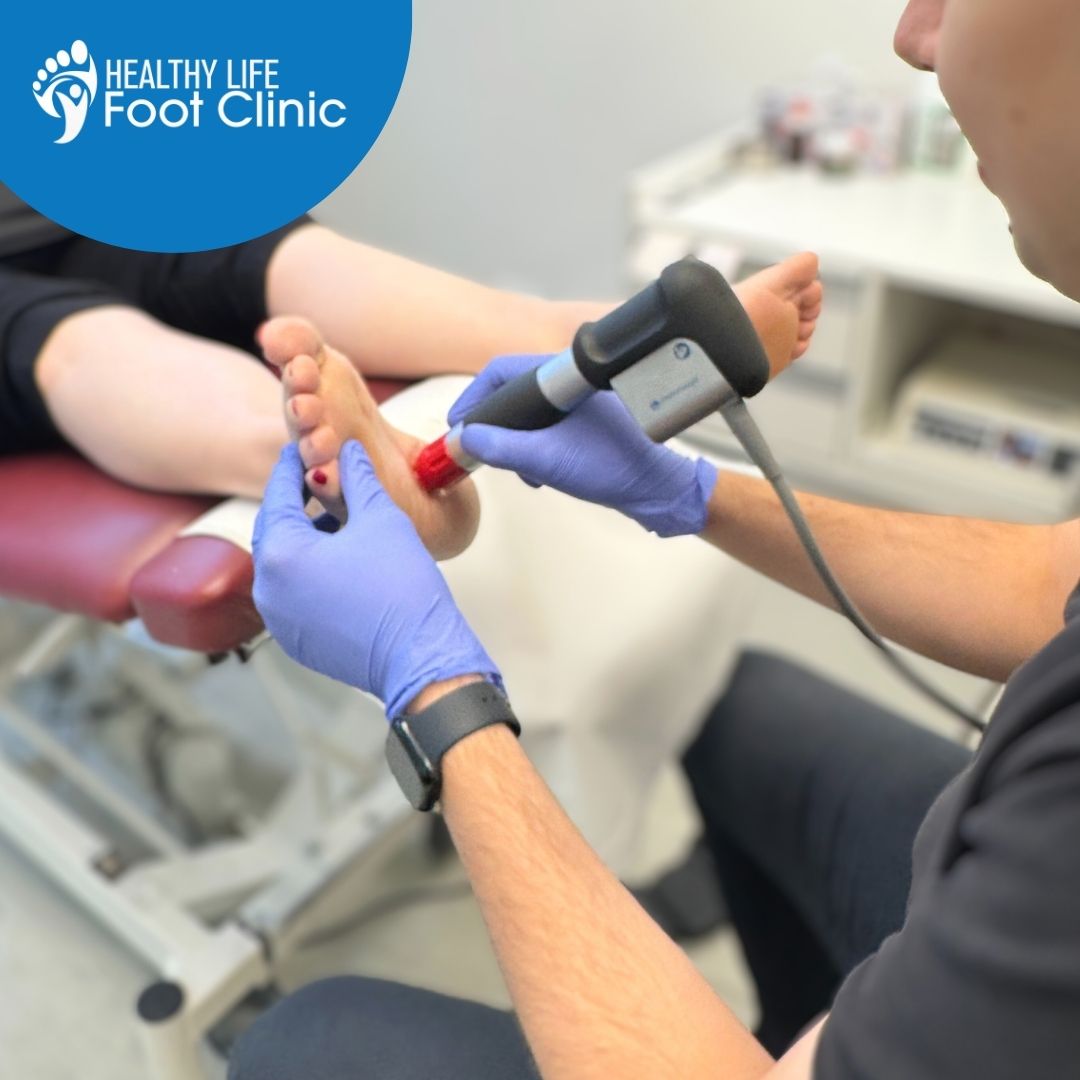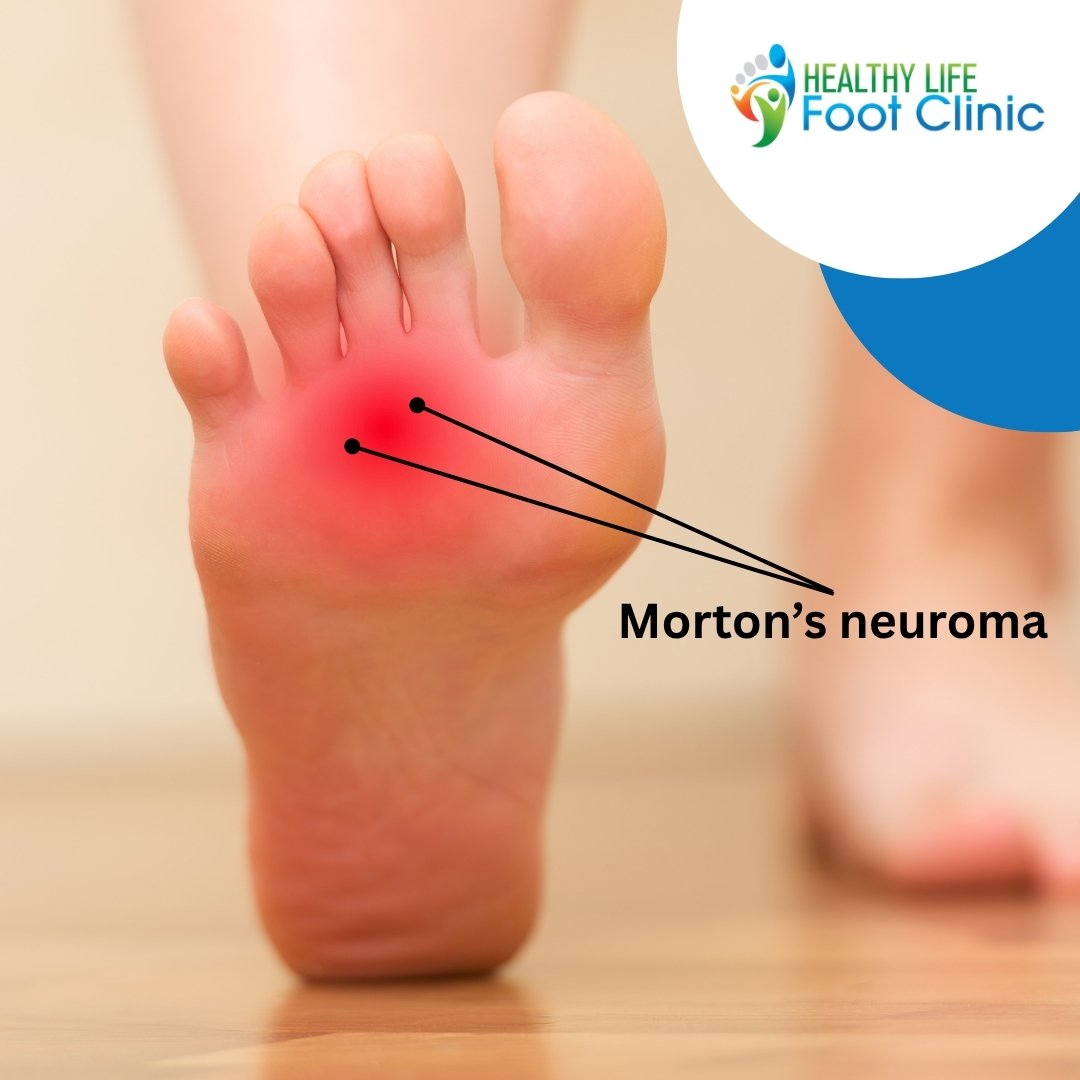Understanding Morton’s Neuroma: Causes, Symptoms, Diagnosis, and Treatment
Ever felt like you’re walking around with a marble or a scrunched-up sock in your shoe? You stop, take the shoe off, shake it out… and nothing. But that weird sensation under the ball of your foot just won’t go away. If that sounds familiar, you might be experiencing something called Morton’s neuroma.
At Healthy Life Foot Clinic, we see this all the time. It’s one of the most frustrating conditions because the pain can sneak up on you and become part of your everyday life without you realising how much it’s affecting your comfort, movement and mood.
But here’s the thing, it’s completely treatable!
This blog will walk you through what it is, why it happens, how to spot it, and most importantly, how we can help you feel good on your feet again.

What is Morton’s Neuroma?
Morton’s Neuroma, sometimes referred to as an interdigital neuroma, is a thickening or irritation of one of the nerves between the toes—most commonly between the third and fourth toes. This thickened nerve tissue results from compression or chronic irritation, which can lead to a cascade of painful symptoms.
It’s important to note that Morton’s Neuroma is not a true tumour, despite the term “neuroma.” It’s more accurately described as a perineural fibrosis, which is a benign growth of nerve tissue caused by ongoing trauma or stress to the nerve. Over time, this results in swelling and inflammation that can severely affect day-to-day activities.
Need a Podiatrist for Morton’s Neuroma?
Find Out More About Healthy Life Foot Clinic’s Care Guarantee
Contact Us or Book Online 24/7
Common Symptoms of Morton’s Neuroma
Symptoms can vary depending on the severity of the condition, but the hallmark signs of Morton’s Neuroma include:
- A burning or sharp pain in the ball of the foot
- A tingling or numb sensation radiating into the toes
- Feeling as if there’s a small pebble or fold in the sock
- A clicking sensation when pressing between the toes
- Pain that worsens with walking, standing, or wearing tight shoes
Often, symptoms develop gradually and worsen over time. Many people find temporary relief by removing their shoes and massaging the area. However, without proper treatment, the symptoms can become chronic and increasingly disruptive.
What Causes Morton’s Neuroma?
There is no single cause of Morton’s Neuroma, but several contributing factors can increase your risk:
1. Poor Fitting Footwear
Shoes that are too tight, narrow, or have high heels are common culprits. These shoes can compress the toes and increase pressure on the forefoot, leading to nerve irritation.
2. Foot Structure and Biomechanics
Certain foot types are more prone to developing neuromas. People with hypermobile feet, a flexible forefoot valgus, or foot instability may place uneven pressure on the metatarsal heads, which can irritate the nerves.
3. Repetitive Stress and Impact Activities
Athletes and individuals who engage in high-impact sports or spend long periods on their feet are more likely to develop Morton’s Neuroma due to ongoing microtrauma in the forefoot.
4. Foot Deformities
Conditions like bunions, hammertoes, or previous injuries to the foot can change the alignment and increase pressure in the area between the toes.

How is Morton’s Neuroma Diagnosed?
If you’re experiencing persistent foot pain, particularly in the ball of your foot or between the toes, it’s important to see a registered podiatrist.
Physical Examination
Your registered podiatrist will begin by asking about your symptoms, footwear habits, and activity levels. They’ll perform a hands-on examination, checking for tenderness and signs of swelling. A key test often used is called Mulder’s Sign, where the foot is squeezed from the sides while pressing between the toes. If this elicits a clicking sensation or reproduces your symptoms, it’s a strong indicator of a neuroma.
Imaging
While X-rays won’t show a neuroma, they are often used to rule out other causes of foot pain such as fractures or arthritis. Ultrasound and MRI scans can help visualise soft tissue and confirm the presence of nerve thickening or inflammation.
Need a Podiatrist for Morton’s Neuroma?
Find Out More About Healthy Life Foot Clinic’s Care Guarantee
Contact Us or Book Online 24/7
What’s the Best Treatment for Morton’s Neuroma?
The good news is that most cases of Morton’s Neuroma can be managed effectively without surgery, especially when caught early. These non-invasive treatment options will usually include:
1. Footwear Assessment
Ill-fitting or restrictive footwear is a major contributor to neuroma-related forefoot pain. Changing your shoes can make a significant difference in relieving symptoms. Look for shoes with a wide toe box and avoid high heels. Sometimes, simply adjusting the way you lace your shoes—especially if you have a wide forefoot—can improve comfort. Your podiatrist can guide you through these modifications.
2. Biomechanical Assessment and Gait Analysis
Understanding how your foot moves and bears weight is key to accurate diagnosis and treatment planning. Your podiatrist may assess for conditions such as hypermobility or forefoot valgus, both of which can contribute to nerve irritation. Based on these findings, a tailored treatment approach will be developed.
Depending on the cause and severity of your condition, your podiatrist may incorporate a range of non-invasive therapies, including:
- Massage
- Stretching and strengthening exercises
- Custom orthotics designed specifically for neuroma relief
Improving foot posture and addressing abnormal loading patterns can significantly reduce stress on the nerve. Orthotics often include metatarsal domes or neuroma-specific padding to reduce nerve compression. These devices also help to stabilise an overly mobile forefoot and prevent the metatarsal bones from irritating or pinching the nerve.
Foot Mobilisation Therapy (FMT) offers a gentle, hands-on approach to alleviate symptoms associated with Morton’s Neuroma. By restoring normal joint movement in the foot and ankle, FMT helps reduce compensatory strain on surrounding tissues, potentially decreasing nerve irritation in the forefoot. This therapy can be an effective component of a comprehensive, non-invasive treatment plan aimed at relieving pain and enhancing foot function.
Shockwave therapy offers a non-invasive treatment option for Morton’s Neuroma by delivering targeted acoustic waves to the affected area. This stimulates the body’s natural healing processes, promoting tissue regeneration and reducing inflammation around the irritated nerve. As a result, patients often experience significant pain relief and improved foot function without the need for surgery.

If conservative, non-surgical treatment options fail to provide sufficent relief of Morton’s neuroma symptoms, more invasive techniques are available. These may include:
3. Anesthetic/Cortisone Injections
Injections containing a local anaesthetic combined with corticosteroid can serve both diagnostic and therapeutic purposes. If pain is temporarily relieved following the injection, it supports the diagnosis of Morton’s Neuroma. At the same time, the corticosteroid component helps to reduce inflammation around the nerve, potentially providing longer-term symptom relief.
This treatment option is typically considered after conservative measures have been trialled and when symptoms persist. It is more commonly recommended for moderate to advanced cases and is ideally performed under ultrasound guidance to ensure accurate placement and improved effectiveness.
4. Morton’s Neuroma Surgery
Surgery is typically considered the final option for treating Morton’s Neuroma and is generally only recommended when all other conservative and minimally invasive treatments have failed to provide adequate relief. The procedure involves removing the affected nerve tissue and is performed by a specialist Foot and Ankle surgeon.
If this course of action becomes necessary, your podiatrist will discuss the risks, benefits, and referral process with you in detail.
Need a Podiatrist for Morton’s Neuroma?
Find Out More About Healthy Life Foot Clinic’s Care Guarantee
Contact Us or Book Online 24/7
3 Simple Tips to Ease Morton’s Neuroma Pain
While professional treatment is essential for long-term management, there are several simple things you can do at home to help relieve symptoms:
1. Change Your Footwear
Switch to shoes that have a wide toe box and offer good cushioning and support. Avoid high heels or tight-fitting styles that compress the front of the foot.
2. Modify Your Activity
Reduce or modify exercises that place excessive pressure on the forefoot—particularly running or jumping-based workouts.
3. Speak to Your Podiatrist About Forefoot Volume Lacing
Re-lacing your shoes to allow more space across the forefoot can prevent the metatarsal bones from compressing the nerve. This method is especially effective for people with broader feet.
Final Thoughts
Morton’s Neuroma can be a frustrating and painful condition, but with early diagnosis and the right management plan, relief is absolutely achievable. If you’re experiencing unexplained pain in the ball of your foot or numbness in your toes, don’t ignore it—seek advice from a podiatrist.
Through a combination of proper footwear, targeted therapies, and expert care, you can return to comfortable, pain-free movement.
If you suspect you may have Morton’s Neuroma, our podiatry team with more than 65 years of combined experience is here to help. Book a consultation today and take the first step toward lasting relief.
Need a Podiatrist for Morton’s Neuroma?
Find Out More About Healthy Life Foot Clinic’s Care Guarantee
Contact Us or Book Online 24/7

